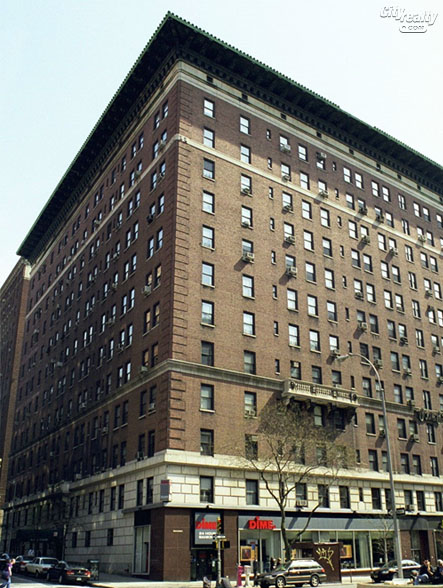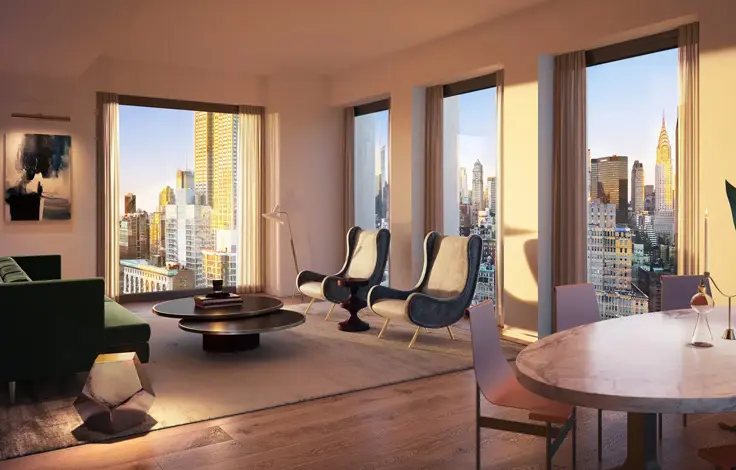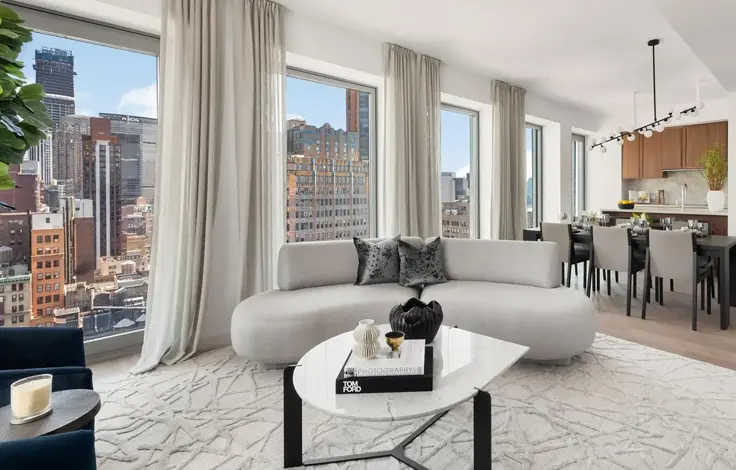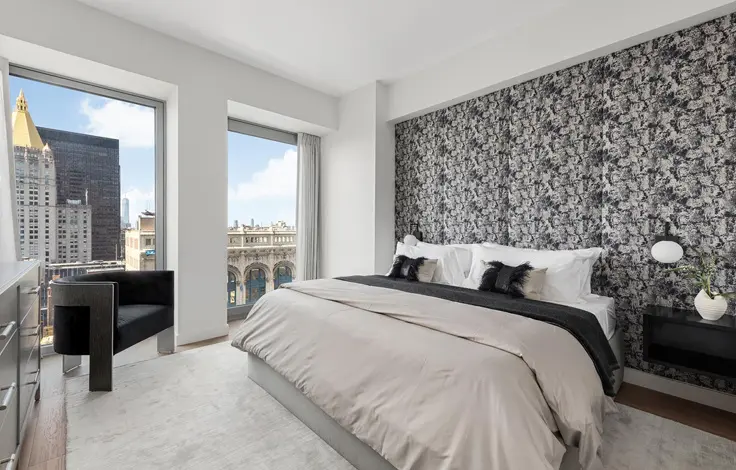Astor Court, 210 West 90th Street: Review and Ratings
at The Northeast corner of Broadway View Full Building Profile


This distinguished, 13-story, red-brick, apartment building at 210 West 90th Street is one of the city's grand apartment buildings in the shape of a “U” with the opening on its eastern façade that is mostly hidden from public view.
The through-block building, which is known as Astor Court, also has an entrance at 205 West 89th Street and its garden is partially visible through its side-street entrances.
It was built in 1915 by Vincent Astor and designed by Charles A. Platt.
It is a co-operative with 158 apartments.
Bottom Line
One of the grand apartment houses of the Upper West side with a very grand and large cornice and a very nice, side rear landscaped courtyard.
Description
The building has one of the city’s largest and most dramatic cornices although it is missing some detailing in the middle of the building’s Broadway frontage.
The building has a two-story, rusticated, limestone base beneath a limestone bandcourse. There is another bandcourse above the fourth floor and with some ornate balconies on Broadway. There is a string course above the 10th floor and a bandcourse beneath the 13th floor and between its window.
The red-brick building has a two-story, rusticated limestone base, very nice lobbies, attractive wrought-iron window grates on the first floor, and impressive bronze lanterns flanking the entrances. It has one-step-up entrances.
The three other famous garden courtyard luxury apartment buildings on the Upper West Side are the Dakota at 1 West 72nd Street, the Belnord at 225 West 86th Street and the Apthorp at 2211 Broadway at 79th Street, but these gardens are fully enclosed.
The lively area has many restaurants and stores. There is a subway station at 86th Street where there is also excellent cross-town bus service.
Amenities
The building has doorman, a roof deck, a garage, a children's playroom, a bicycle room, a laundry room, and a resident manager.
It is pet friendly, but has no sidewalk landscaping and no fitness center.
Apartments
Apartments have wood-burning fireplaces and 10-foot-high ceilings.
Apartment 2B is a three-bedroom unit with an 11-foot-long entry foyer that leads to a 14-foot-long gallery that opens on one side to a 21-foot-long living room with a wood-burning fireplace and on the other side to a 19-foot-long, windowed dining room next to a 20-foot-long, windowed kitchen.
Penthouse 4 is a two-bedroom unit with a 6-foot-square entry foyer that leads up a step to the 13-foot-square skylit dining room and 8-foot-wide kitchen and the 13-foot-long living room with wood-burning fireplace and a very large patio. The master bedroom also has a skylight.
Penthouse A is a three-bedroom unit with a 22-foot-long entry foyer that leads past a 9-foot-long office to a long hallway with an eat-in, 17-foot-long kitchen to the 29-foot-wide living room with a 22-foot-long terrace that is also entered from the kitchen.
Apartment 7B is a four-bedroom unit with a 10-foot-long entry foyer that leads to a 14-foot-long gallery that opens on one side to a 21-foot-long living room with wood-burning fireplace and on the other side to a 19-foot-long, enclosed dining room next to a 12-foot-long breakfast room and a 14-foot-long, windowed kitchen.
Apartment 4F is a two-bedroom unit with a 14-foot-long entry foyer that leads to a 22-foot-long living room with a wood-burning fireplace next to an eat-in, windowed, 14-foot-long kitchen.
Apartment 12J is a two-bedroom unit with a 12-foot-long entry foyer that leads to a 11-foot-long curved dining area next to a windowed kitchen and an 18-foot-long living room with a wood-burning fireplace.
Apartment 10E is a one-bedroom unit with a wide entry gallery that leads to a 10-foot-long foyer that opens onto a 20-foot-long living room with two slightly angled corners and an 11-foot-long windowed kitchen with an angled corner.
History
At his death in 1969, Vincent left his widow, Brooke, control of a charitable foundation worth about $60 million.
In his September 10, 2006 "Streetscapes" column in The New York Times, Christopher Gray wrote that "What is less well known is how Vincent Astor, inheriting the family fortune as a college freshman, used it to shape an unusual real estate career that left a rich and original legacy on the New York streetscape."
"The fortune was first accumulated by John Jacob Astor, who by the time he died in 1848 had amassed $20 million, much of it in real estate. By 1890, the money was controlled by two family branches, one headed by John Jacob Astor IV, Vincent’s father. Vincent Astor grew up in delicate health; he was at Harvard in April 1912 when word came that the Titanic had gone down with his father on board. Suddenly, a fortune of $87 million - $65 million of it in real estate - descended on a young man whose only proven passion was for fast cars."
"His first development project appears to have been a chaste tapestry-brick warehouse at 4 Ninth Avenue, which he completed in 1913. At the same time he embarked on an exceptionally unusual renovation, for which he retained the architectural firm of Tracy & Swartwout. Taking a group of 10 back-to-back old houses on 43rd and 44th Streets just west of Times Square, Astor combined them as a single apartment complex with a central courtyard. It took only a simple fountain, some trees, a few pieces of furniture and some grass to turn the old buildings inside out as a little refuge, a very early instance of what was later a common technique. The complex, Westover Court, vanished in 1925, replaced by the Paramount Building," according to Mr. Gray.
"In 1914, Astor started another much larger project: the $1 million Astor Court apartments on Broadway from 89th to 90th Streets. Here, working with the artist and architect Charles Platt, he erected a façade of brick and stone so carefully detailed that it might have evoked a private club, except that it was 13 stories high. Architectural critics had been complaining for years that as buildings had grown in height, their cornices had started looking puny. Platt and Astor actually did something about it. Astor Court’s great copper cornice projects out eight feet and was painted in gold and red, as classical monuments once had been," the article said.
Platt, Mr. Gray continued, "forsook the automobile turnarounds so common at other buildings, substituting instead a series of brick walks and plantings. Nothing like it had been done in New York, and its design remains one of the most thoughtful in the city."
"Five blocks away," the article said, "Astor was simultaneously working on a project related to his interests in model farming: a model market at 95th and Broadway, finished in 1915. His architects, Tracy & Swartwout, developed a high one-story arcaded façade of mottled travertine. Under the cornice ran a 290-foot-long frieze by William Mackay depicting a market procession, with farmers and dealers carrying meat, fish, poultry, fruit and vegetables in everything from medieval carts to motor trucks. Jules Guerin, an artist, designed festive banners for high flagpoles.
The Astor Market closed in 1917 and was been demolished.
"By the late 1920’s, Astor recaptured some of his architectural ambitions in his attempt to remake a section of East End Avenue, then an area of modest apartment buildings, into a high-toned residential enclave. First, he built two tasteful apartment houses at 520 and 530 East 86th Street, also by Platt. Then, he had Platt design a sumptuous apartment building around the corner, the severe all-limestone 120 East End Avenue, at 85th Street. The three buildings benefited from parcels that Astor acquired for extra light and air - an unusually enlightened if expensive touch," the article said.
At Astor Court, Platt designed "the rear façades in buff brick, lighting up what might at some points be gloomy," observed Mr. Gray in an earlier "Streetscapes" column, July 1, 2001. "And he raised the garden level a few feet above the lobbies, avoiding the sunken feeling present in some rear areas," he continued, adding that "Astor sold the building in 1922 and by 1935 it was owned by Henri Bendel, of women's clothing-store fame, who divided some of the apartments" and "later a garage was created in the basement, with a ramp from the 89th Street side."





 6sqft delivers the latest on real estate, architecture, and design, straight from New York City.
6sqft delivers the latest on real estate, architecture, and design, straight from New York City.
